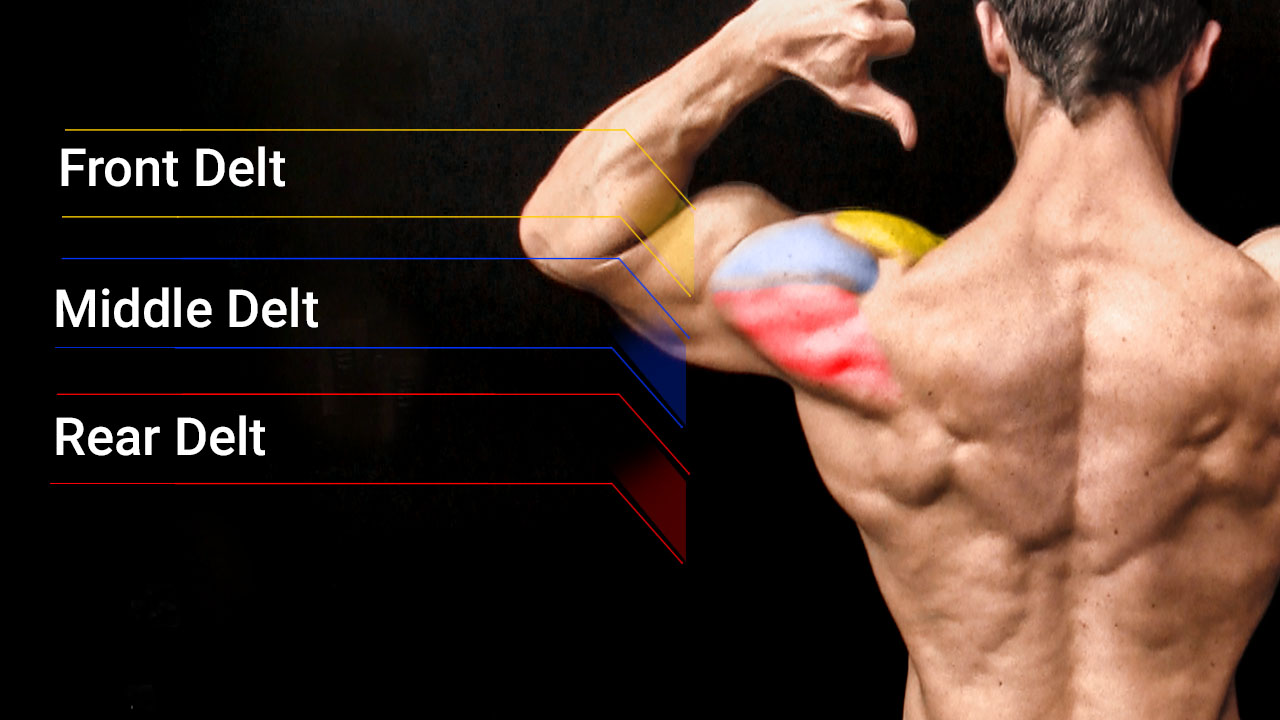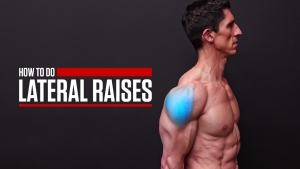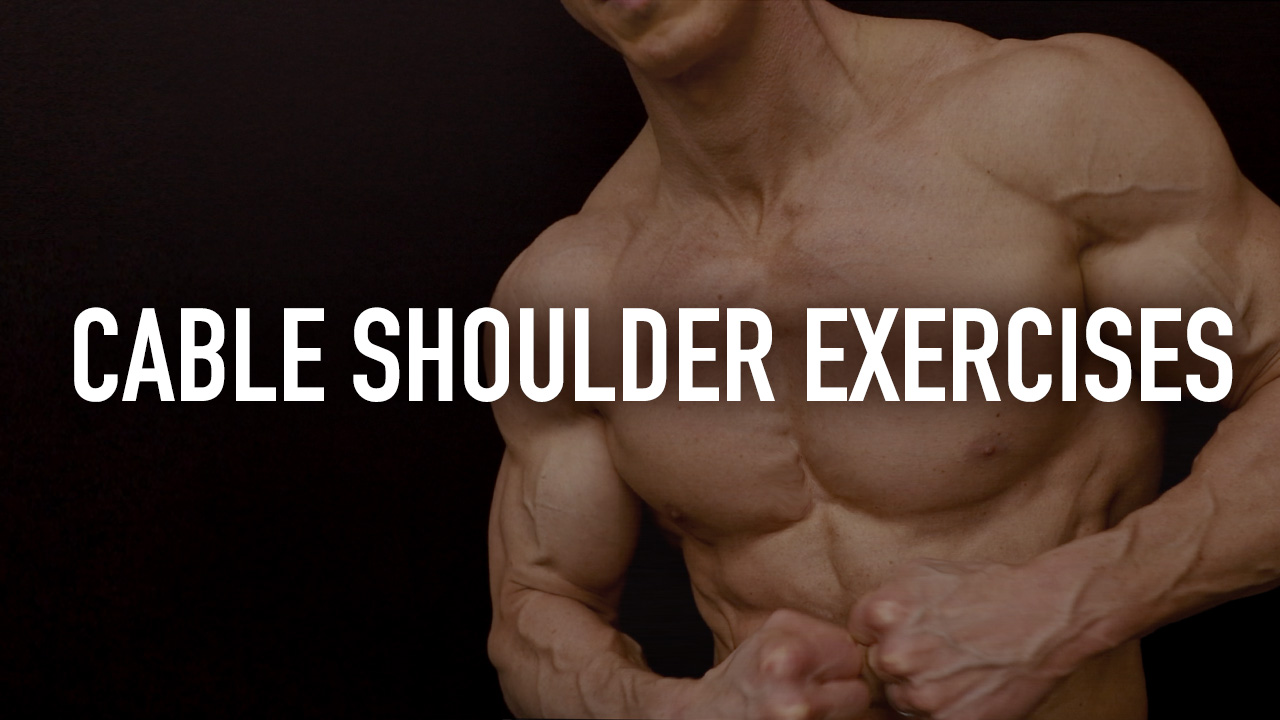
CABLE SHOULDER EXERCISES
Guys, today, we’re diving into cable shoulder workouts – an effective yet often overlooked approach to shoulder training.
The shoulder joints are one of the most complex and versatile joints in the body.
And it’s crucial to train the shoulder muscles in a way that not only builds strength and size but also maintains mobility and minimizes the risk of injury.
That’s where cable machines and cable shoulder workouts come in.
Unlike barbell or dumbbell shoulder workouts, cables offer consistent tension throughout the exercise, a key factor that can lead to better engagement and muscle growth.
A shoulder workout with cables can also address muscle imbalances and reduce the risk of shoulder injury.
Let’s first take a closer look at the shoulder muscle.Then I’ll go through an entire list of the best cable shoulder exercises that you can start using in your workout today.
ANATOMY OF THE SHOULDERS
It’s just as important (more so) to know how the muscle fibers work as it is to learn effective shoulder exercises for them.
And that’s why I’m kicking things off with a breakdown of the shoulder muscles before getting into the wider range of exercises.
What we think of as the shoulder muscle consists of three deltoid heads: anterior (front), lateral (side), and posterior (rear).
These three heads have a synergistic role with the rotator cuff. When the deltoids contract to move the arm, the rotator cuff muscles engage and act like stabilizer muscles for the shoulder joint.
An effective shoulder workout is going to have exercises that use common attachments for the cable machine and target all three heads of the deltoid muscles.
ANTERIOR DELTOID (FRONT DELTOID)
As the name suggests, you can find the anterior deltoids on the front of your shoulder, contributing to the rounded contour of the muscle.
The anterior delts start at the clavicle, providing a pivotal base for their function and movement, and they are responsible for the following:
- Shoulder Flexion: Front delts are primary movers in lifting the arm forward, playing a vital role in exercises like the Cable Front Raise.
- Internal Rotation and Pressing Movements: They are also essential in rotating the arm inwards (internal shoulder rotation) and in pushing movements. For example, the standard shoulder press exercise on the shoulder press machine as well as cable movements such as the Cable Shoulder Press and the Single Arm Cable Shoulder Press.
LATERAL DELTOID (MIDDLE DELT)
The muscles on the outer part of your shoulders, called lateral deltoids, start from a specific point on your shoulder blade called the acromion process.
This spot is important because it helps control how these muscles move and work.
The middle head of the deltoids is responsible for:
- Shoulder Abduction: This is the star function of the middle portion of the deltoids. They power lateral raise movements or lifting your arms out to the side, such as the Bent-Over Single-Arm Lateral Raise and the Cable Lateral Raise.
- Stabilization and Synergy: Besides lifting, they play a vital role in stabilizing the shoulder joint, especially during dynamic movements.
REAR DELT
The rear or posterior head of the deltoids is located at the back of the shoulder. It originates from the scapula’s spine, extending from the base of the neck to the shoulder.
There are a larger range of essential functions of the posterior deltoids including:
- Shoulder Horizontal Abduction: Vital in movements where you move your arms away from the midline of the body in a horizontal plane, like when performing the Reverse Fly, Rear Delt Crossover, and Bent-Over Rear Delt Flyes.
- External Rotation: The rear delts also assist in rotating the arm outward. External shoulder rotation is a movement commonly involved in various pulling and rear delt exercises like the Cable Face Pull.
- Shoulder Extension: They play a role in moving the arm backward, crucial in rowing movements and when bringing the arm behind the body.
BEST CABLE SHOULDER EXERCISES
Now that you know where the deltoid heads are, you’re going to have a much easier time activating and contracting them during the following effective exercises.
Whether this type of cable machine exercises is new to you or a refresher, I want you to start with a lighter load for the first few warm-up sets.
Focus on creating your own resistance with light weight before moving up to the heavier weight plates.
You might even want to consider using a resistance band for a set or two to really get the muscle warmed up and ready to go.
There are lots of cable shoulder movements to choose from, but here are my top picks for shoulder cable exercises.
Keep in mind that you’ll only need the basic attachments for shoulder exercises such as an adjustable pulley, cable handles, and a rope handle.
You’ll also notice that I’m focusing on the individual heads of the deltoids. We’re starting with the front, then going to the medial delt with a lateral raise movement and then finishing strong with the rear delt muscles.
Ready to get started?
CABLE STRETCH FRONT RAISE

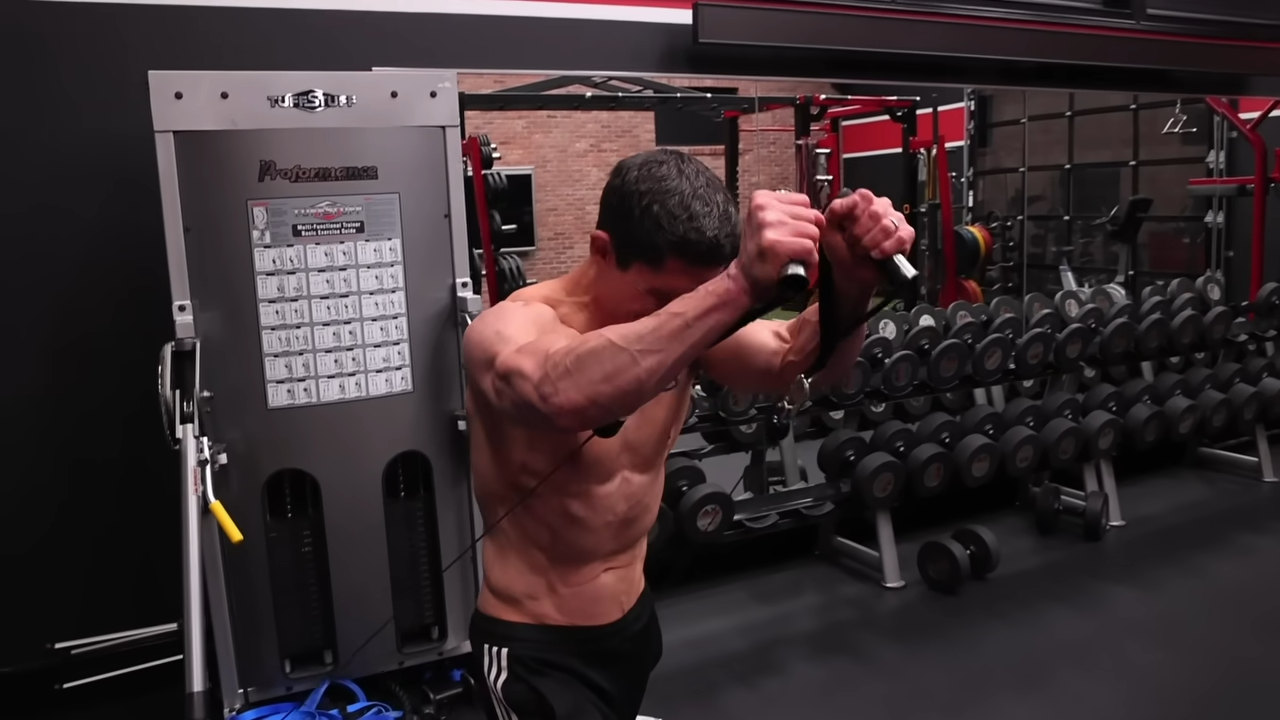
HOW TO DO CABLE STRETCH FRONT RAISES:
- Attach cable handles to the low pulleys of a Cable Crossover machine.
- Stand facing away from the cable machine, about a foot or two from it.
- Bend forward slightly and grab the cable handles with an overhand grip. If you were to use an underhand grip, you would turn this into a chest exercise so keep that in mind.
- Step forward until you feel a stretch in your front shoulder, keeping your arm straight but not locked at the elbow.
- Exhale and slowly raise your hands at shoulder height. If you’re struggling with the last few reps, aim for mid-chest level. The movement should be controlled, and your torso should remain stationary.
- Hold the top position for a brief second. Ensure your wrist remains neutral, and you’re lifting with your shoulder muscles, not your traps.
WHAT MAKES IT EFFECTIVE: This is a fantastic exercise with a great range of motion that allows you to get those front deltoids into a position of stretch. This is something you don’t often get if you’re just doing a traditional Standing Dumbbell Front Raise. It’s excellent for improving shoulder mobility. It can also be performed with a curl bar, but this would have the same entire range of motion.
RELAY RAISES

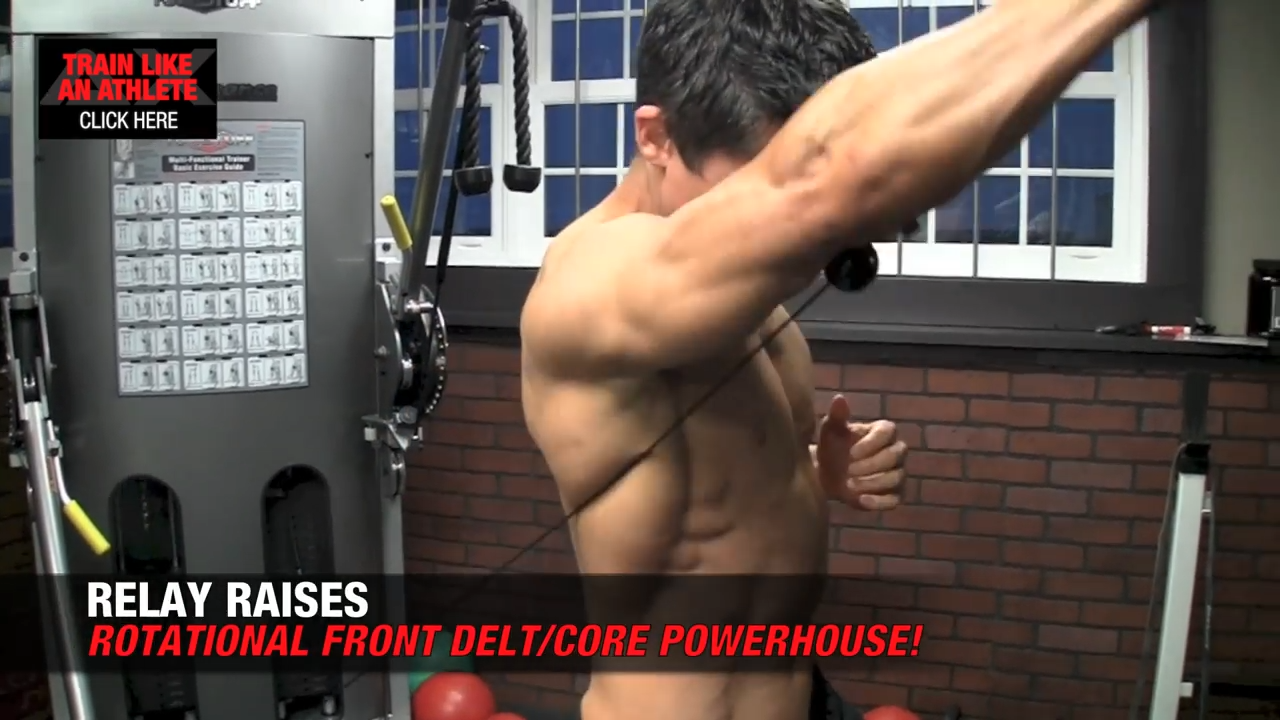
HOW TO DO RELAY RAISES:
- Set the cable pulley machine to its lowest setting.
- Stand with your feet shoulder-width apart, with a slight stagger in your stance for stability. Face away from the cable machine.
- Grasp the handle with one hand, palm facing forward. This hand will be doing the exercise.
- Keep the core tight and maintain an upright posture.
- Using the shoulder muscle, push the handle forward and upward in a smooth, controlled motion. Your arm should move in a diagonal path, not straight up.
- Continue the motion until your arm is fully extended but avoid locking the elbow.
- Slowly and with control, lower the weight back to the starting position. Ensure this entire movement is just as controlled as the upward phase.
WHAT MAKES IT EFFECTIVE: This is one of those isolation exercises for the front delt that is known for its stimulus and developing powerful shoulders. One of the great exercises for shoulder development and strength in the shoulders.
CABLE LATERAL RAISES


HOW TO DO CABLE LATERAL RAISES:
- Adjust a cable machine so that the pulley is set at hip level. Attach a handle to the pulley.
- Stand perpendicular to the machine, with your side facing the cable stack. The cable should be on the opposite side of the shoulder you want to work on first.
- Stand with feet shoulder-width apart for stability and get into a slightly bent-over position.
- Grasp the handle with your palm facing your body. Your arm should be extended in front of your body with a pre-stretch on the muscle.
- Lift the handle out to the side of your body, keeping a slight bend in your elbows. Elevate your arm until it is parallel to the floor (shoulder level).
- Keep your wrist in a neutral grip position and ensure that your elbow and shoulder are moving in harmony.
- The motion should be slow and controlled, focusing on using the shoulder muscle to perform the lift without relying on momentum.
WHAT MAKES IT EFFECTIVE: One of my favorite cable machine shoulder exercises, the setup of the Cable Lateral Raise ensures you already have a pre-stretch on the muscle. As you pull across and up to the side, you’re keeping constant tension on the medial head of the deltoid. This one is great for building broad shoulders.
LATERAL AND REAR COMBO SIDE RAISE

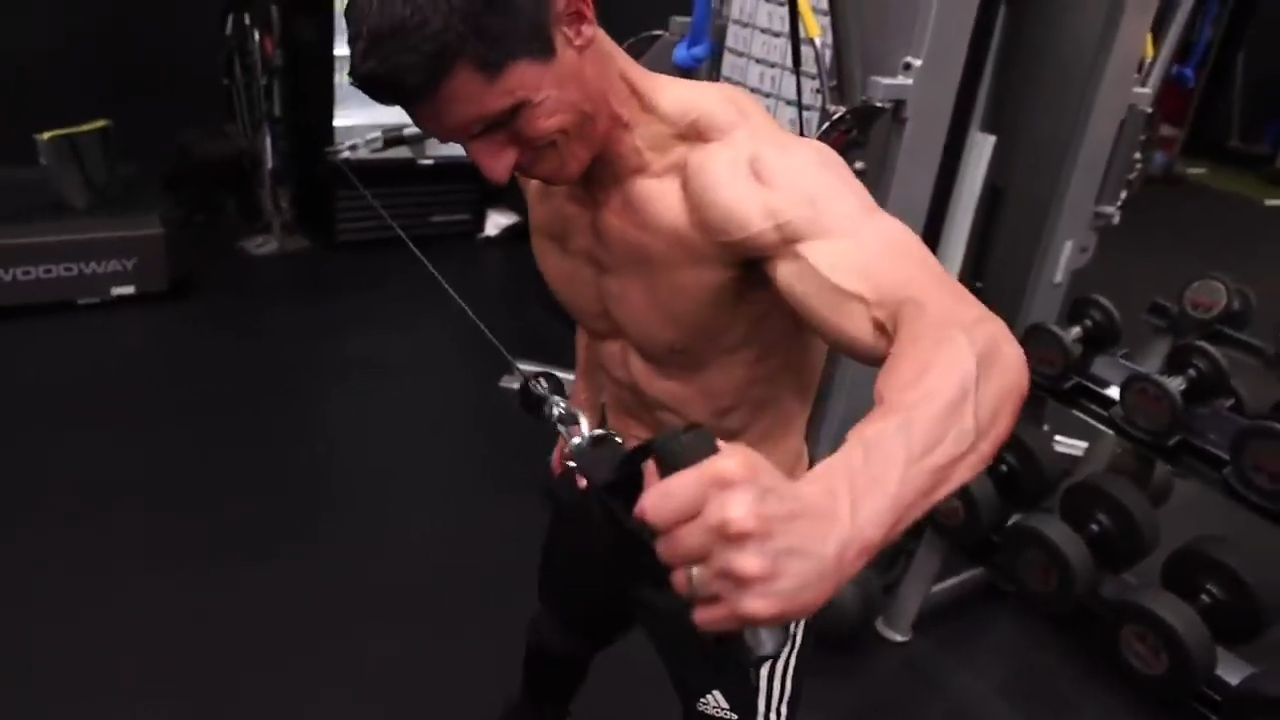
HOW TO DO LATERAL AND REAR COMBO SIDE RAISES:
- You’re going to follow the same setup as above, but when you stand next to the cable machine, turn your feet and body 45 degrees.
- Position the cable machine by setting the pulley to align with your hip. Attach a handle to this pulley.
- Position yourself sideways next to the machine, so the cable handle is opposite the shoulder you’re targeting first. Now, turn your body 45 degrees.
- Adopt a stable stance, keeping your feet apart at shoulder width.
- Hold the handle with the palm facing inwards, extending your arm across your body to start with a slight stretch in the shoulder muscle.
- Perform the lift by moving the handle away from your body, keeping your arm slightly bent. Raise your arm until it reaches a position level with the floor.
- Execute the lift slowly and with control, focusing on engaging the shoulder muscle and avoiding any momentum-based movement.
WHAT MAKES IT EFFECTIVE: The cable positioning and 45-degree turn of your body makes this an excellent exercise for both the middle deltoids and rear deltoids. First, you get a nice pre-stretch on the middle and rear deltoids. Second, the exercise itself is what happens when a Lateral Raise meets a Row. Finally, it allows you to resist extension of the arm behind the body, which promotes both strength and shoulder muscle growth. Again, another great exercise for broader shoulders.
CABLE FACE PULLS

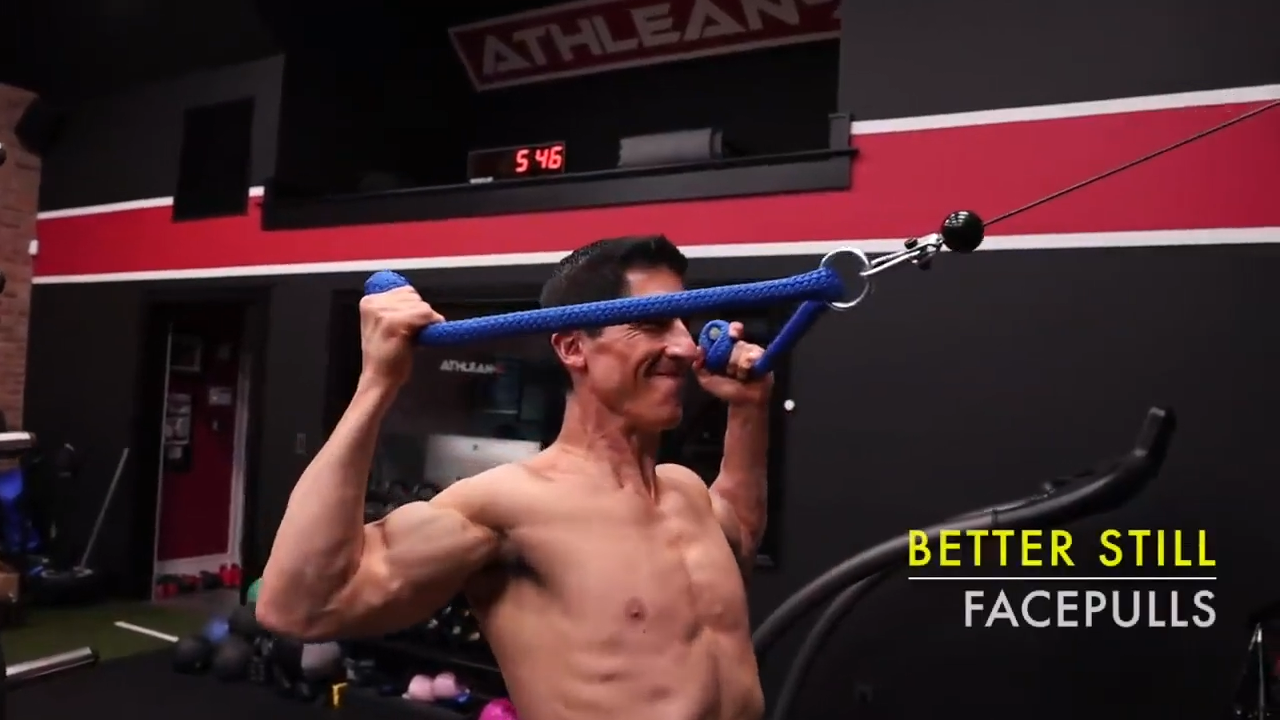
HOW TO DO CABLE FACE PULLS:
- Attach a rope attachment to a cable machine, positioning the pulley at a high level. Ideally, the pulley should be set slightly above head height.
- Stand facing the cable machine, feet shoulder-width apart to keep your body stable.
- Grasp each end of the rope handle with both hands in a shoulder-width grip. Your palms should face each other, and your hands should be at head height.
- Begin by pulling the rope towards your face. As you pull, focus on moving your hands apart and towards either side of your head.
- As you perform the pull, concentrate on retracting your shoulder blades, bringing them together as you move the rope towards your face.
- Aim to pull the rope until your hands are in line with your ears or slightly behind, ensuring that the movement comes from your upper back and shoulders and not just your arms.
- Make sure your chest is out, and you maintain a good upright posture throughout the movement.
- Slowly extend your arms back to the starting position, allowing your shoulder blades to move apart naturally.
- Control the movement both ways – both when pulling the rope towards your face and when returning to the starting position.
- You can perform this movement on a bench but it’s best to do so in a standing position.
WHAT MAKES IT EFFECTIVE: The Cable Face Pull is one of the essential cable shoulder exercises that I recommend. It reverses a lot of the tension that naturally builds up during our day-to-day routine that focuses on frontal and pushing movements. It also helps to build up the upper back muscles. You need to add this cable rear delt exercise into your routine (if you haven’t yet).
CABLE OVERHEAD RAISE FACE PULLS

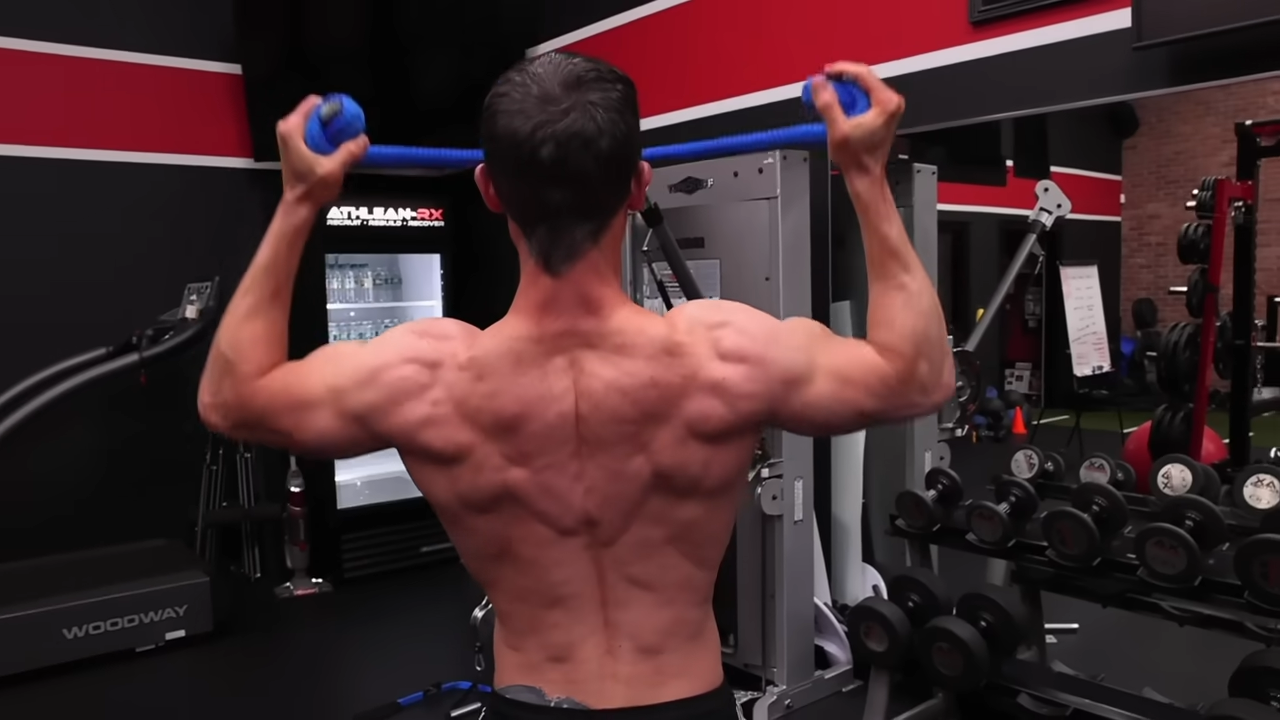
HOW TO DO CABLE OVERHEAD RAISE FACE PULLS:
- Attach a rope attachment to a cable machine, setting the pulley at a level slightly above your head.
- Stand facing the cable machine with your feet shoulder-width apart for stability.
- Grasp each end of the rope attachment with both hands, palms facing each other.
- Begin by pulling the rope towards your face, focusing on separating your hands as they come closer to your face.
- As you pull, concentrate on retracting your shoulder blades, squeezing them together.
- Pull the rope until your hands are aligned with your ears, ensuring the movement is driven by your upper back and shoulders.
- From the face pull position, with your hands beside your ears, transition into an Overhead Raise.
- Extend your arms upward, fully stretching them above your head. This movement should be fluid and controlled.
- In the overhead position, your arms should be straight, and your shoulder blades slightly elevated.
- Keep your core muscles engaged to maintain a stable and upright posture.
- Lower your arms back to the face pull position beside your ears. Then, slowly extend your arms back to the starting position, controlling the weight throughout the movement.
WHAT MAKES IT EFFECTIVE: This popular shoulder exercise is a two-in-one combo that targets the rear delts as well as the middle and lower trapezius muscles. This one is great for muscle hypertrophy and building up a strong and solid upper back.
GET THE MOST OUT OF YOUR CABLE SHOULDER WORKOUTS
You know exactly which shoulder exercises to perform, but do you know how to put it all together to get the most out of these workouts?
Let’s break down some important tips for you to know to hit the ground running by reaping the benefits of cable shoulder exercises.
REPETITION RANGES
If you’re aiming for muscle growth – and let’s be honest, who isn’t? – you need to hit that hypertrophy stimulus. This is the range typically between 8 to 12 reps.
But it’s not just about hitting those numbers; it’s how you hit them.
Each rep needs to be controlled, with a focus on intense muscle contraction. Remember, it’s quality over quantity.
When you’re in that 8-12 rep range, really focus on the shoulders doing the work.
It’s easy to let other muscles jump in and take over but keep the focus on the shoulders. This mind-muscle connection is crucial for maximizing gains.
Now, don’t ignore higher rep ranges, especially if you’re looking to improve muscular endurance.
Going for 15-20 reps can be incredibly beneficial. Sure, you’ll have to lighten the load, but the burn you’ll feel? That’s your muscles telling you they’re working hard.
For those of you looking to build upper body strength, don’t be afraid to drop into lower rep ranges with heavier weights. I’m talking about 4-8 reps.
It’s a different kind of stimulus, but it’s just as important. It’s all about progressive overload, challenging your muscles to handle more.
Mix up your rep ranges. Your body is incredibly good at adapting, which means doing the same thing over and over will lead to plateaus.
Throw in some high-rep workouts, some low-rep ones, and of course, hit that hypertrophy range.
WEIGHT LOAD
Let’s start with using a light load. Especially when you’re working with cable stations, starting light is not a sign of weakness; it’s smart training. Why?
Because it allows you to focus on that crucial mind-muscle connection.
This isn’t just lifting weights; this is about engaging the right muscles and doing it effectively.
A lighter load helps you maintain proper form and really target those shoulder muscles without letting other muscle groups take over.
One of the best things about cable stations is the ability to adjust the machine load increments.
This is key for progressive overload.
You don’t need to make huge jumps in weight to see progress. Small increases over time can lead to significant improvements.
Remember, it’s not about ego lifting; it’s about effective lifting.
The versatility of cable stations is one of my favorite things about them, allowing you to work your shoulders from various angles and with a full range of motion.
The weight load you choose should allow you to perform each exercise through its full range without compromising form. This is where you can really take advantage of the cables to hit the muscles effectively.
As mentioned above, your weight load will vary depending on your rep range.
For hypertrophy (8-12 reps), choose a weight that challenges you in the last few reps but still allows you to maintain form.
For endurance (15-20 reps), go lighter to sustain performance throughout the set.
For strength (4-8 reps), you can go heavier, but never at the cost of proper form.
FREQUENCY PER WEEK
First thing’s first: the number of sessions per week. There’s no one-size-fits-all answer, but there are guidelines to maximize your gains while preventing overtraining.
For most people, targeting shoulders two times a week is ideal. Why?
Because this allows enough stimulus for growth and strength, while also providing ample recovery time. Remember, recovery is where the growth happens.
In your first 3-4 weeks, you might feel eager to go all in, but hold up.
Start with one shoulder-specific session per week. This allows your body to adapt to new stresses and challenges, especially if you’re incorporating those varied rep ranges we talked about earlier.
It’s not just about blasting your muscles; it’s about conditioning them to respond and grow.
After the initial phase, your body starts to adapt. Now, you can consider adding that second session per week over the next 6-8 weeks.
But listen to your body – if you’re feeling excessively sore or fatigued, it’s okay to stick with one. This isn’t a sprint; it’s a marathon.
CONCENTRIC VS. ECCENTRIC
The concentric portion is when you’re lifting the weight, contracting your muscles.
In cable shoulder exercises, this is when you’re doing the pressing or lifting motion.
This part is all about generating power. You’re working against gravity, pushing your muscles to their limits.
But here’s the thing: don’t just lift the weight – control it.
When you’re performing the concentric phase, focus on engaging the shoulder muscles, making sure they’re doing the heavy lifting (literally).
Now, let’s talk about the eccentric portion, which is often overlooked but just as important.
This is when you’re lowering the weight back down. Most people just let the weight drop – big mistake.
The eccentric phase is where a lot of the muscle-building magic happens.
When you’re slowly controlling the weight on the way down, you’re actually creating more micro-tears in the muscle fibers.
These tears, when repaired, lead to muscle growth. So, don’t rush this part. Embrace the burn and make every second count.
Guys, if you’ve been sticking to dumbbells and barbells for your shoulder workouts, it’s time to change it up.
Cables offer you some unique benefits including constant tension and a better range of motion.
In fact, no upper body workout is complete without pairing compound exercises with effective exercises for the shoulders.
Don’t have a cable shoulder workout for yourself? We can help with that. Check out our ATHLEAN-X programs to see which is the best fit for your goals and fitness level.

- Effective shoulder cable workouts target all three deltoid heads (anterior, lateral, and posterior) along with the rotator cuff, ensuring a well-rounded approach.
- The constant tension from cables promotes superior muscle growth and activation.
- Cable exercises are safer and lower the chance of injury compared to traditional dumbbell or barbell workouts.
- Cables offer an efficient substitute to conventional weightlifting methods, ensuring diverse and effective shoulder training.
- To target the anterior deltoids (front delts), I’d recommend Cable Stretch Front Raises and Relay Raises.
- If you want to exercise the lateral deltoids (side delts), I’d suggest Cable Lateral Raises.
- Finally, if you want to go after the posterior deltoids (rear delts), you can do Cable Face Pulls.
CABLE SHOULDER EXERCISES FAQS
To train your shoulders using a cable station machine, you can perform a variety of effective cable shoulder workout exercises that target each of the three deltoid heads (front, middle, and rear).
I’d recommend performing Cable Stretch Front Raises and Relay Raises for the anterior deltoids (front delts).
For the medial deltoids (lateral delts), you can do the Cable Lateral Raise and Lateral and Rear Combo Side Raise exercise.
Finally, for the posterior deltoids (rear delts), I’d suggest Face Pulls and Overhead Press Face Pulls.
Cable Lateral Raises are excellent for targeting the side delts.
To perform Cable Lateral Raises:
- Set the cable at the lowest point.
- Stand perpendicular to the machine and grab the handle attachment with the hand farthest from the machine.
- Raise your arm to the side, keeping it slightly bent, until it's parallel with the floor.
- Ensure your movement is slow and controlled, focusing on the side deltoid.
Yes, cable machine shoulder workouts are excellent.
They provide constant application of tension throughout the movement, which can lead to increased muscle activation compared to free weights.
Cables also allow for a greater range of motion and can be adjusted to hit the deltoid muscles from various angles.
Dumbbell shoulder workouts are also a great way to build your shoulders, but they lack the consistent tension that you’ll get with cables and resistance bands.
Cable Rows primarily target the back, specifically the lats, rhomboids, and traps.
However, they do offer some benefits to the rear deltoids and the overall shoulder region, especially in stabilizing and controlling the movement.
It depends on the type of shoulder cable pulling movement. For example, Face Pulls are a type of cable pull exercise that effectively targets the rear deltoids, which are crucial for shoulder health and stability.
The Bent-Over Cable Row is another pulling movement but it’s going to target your back, not your shoulders.
This depends on the type of Cable Flys you’re talking about.
Traditional Cable Flys – also referred to as Cable Crossovers – are known for targeting the chest. With that said, they do involve the anterior deltoids (front part of the shoulders) but not enough to qualify it as a shoulder exercise.
On the other hand, the Reverse Cable Fly with a high cable pulley can target the rear deltoids.
Absolutely! A Cable Shoulder Press can be done either standing or seated on a bench with a straight bar attachment or cable pulley handles.
It's performed similarly to a Dumbbell Press but with cables. This variation provides constant tension throughout the movement and can be easier on shoulder joint health due to the natural arc movement created by the cables. It’s also great for shoulder muscle growth.
REFERENCES

Jeff Cavaliere M.S.P.T, CSCS
Jeff Cavaliere is a Physical Therapist, Strength Coach and creator of the ATHLEAN-X Training Programs and ATHLEAN-Rx Supplements. He has a Masters in Physical Therapy (MSPT) and has worked as Head Physical Therapist for the New York Mets, as well as training many elite professional athletes in Major League Baseball, NFL, MMA and professional wrestling. His programs produce “next level” achievements in muscle size, strength and performance for professional athletes and anyone looking to build a muscular athletic physique.
















